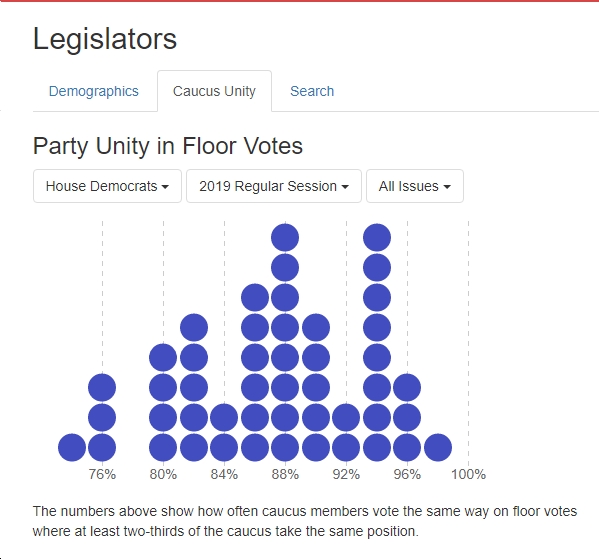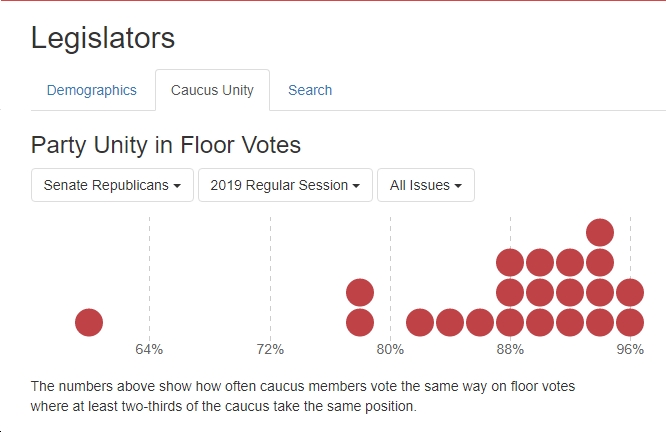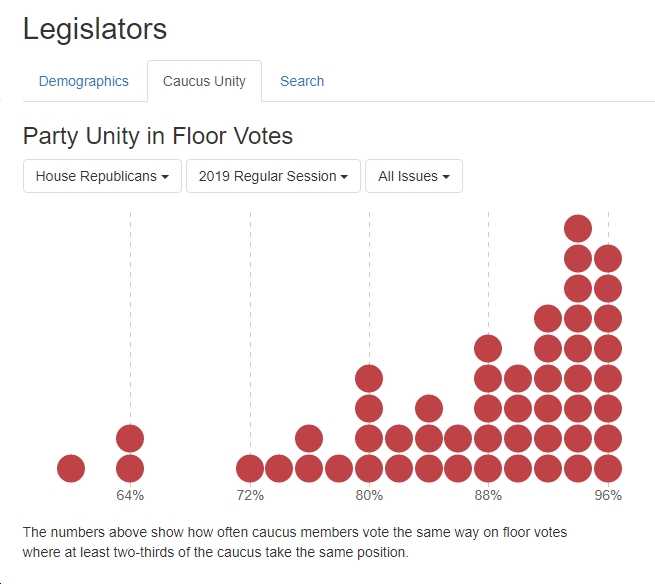VPAP has some interesting stats on Virginia General Assembly members’ “party unity in floor votes.” Of course, a lot of the real “action” in the Virginia General Assembly occurs in subcommittees and committees, well before bills make it (or in most cases do NOT make it) to the House of Delegates or Senate floors, so these statistics only capture part of the story. Still, despite the limitations of the following graphics/statistics, there’s some interesting stuff that jumped out at me. Let’s start with Senate Democrats (see graphic, below, followed by what jumped out at me).

- Being on the far-left of this graphic does not at all equate to being far-left ideologically. In this case, the furthest-“left” would be Sen. Chap Petersen, clocking in at 61.6% party unity on floor votes so far during the 2019 regular session. With Sen. Petersen, that’s almost certainly a result of him being an iconoclast and not particularly a “team player” (unless that team is his beloved R**skins, of course – haha). Note that VAPLAN scored Sen. Petersen in the middle of the Senate Democratic pack last year, so his ideological leanings don’t seem particularly correlated with his party unity score.
- Also not scoring particularly high in terms of party unity are Senators Scott Surovell (73.3%), Creigh Deeds (73.0%) and Lionell Spruill (76.4%). In the case of Sen. Surovell, VAPLAN scored him similarly to Sen. Dick Saslaw, who has a party unity score of 94.5%, so again I’m not seeing any particular correlation between ideology and party unity (note: Surovell and Petersen, who were law partners for years, both definitely have a strong independent/feisty streak). Sen. Deeds ranked as the eighth-most-progressive State Senator in VAPLAN, but Sen. Adam Ebbin was second-most progressive, and his party unity score is 88.0%. As for Sen. Spruill, VAPLAN ranked him as the second-most-conservative Democrat (Rosalyn Dance was the most conservative Dem), so maybe that has something to do with his relatively low party unity score (although Dance, who rated as even more conservative than Spruill, has a party unity score of 93.2%)? Or maybe Spruill’s votes are more about his district or other factors? Got me.
- Not surprisingly, given that he’s the Senate Democratic Leader, Dick Saslaw had the highest party unity score (since he’s basically voting with himself – lol), at 94.5%.
- Also scoring very high in terms of party unity are some of Saslaw’s closest allies – Sen. George Barker (93.3%), Sen. Barbara Favola (93.3%) and Sen. Dave Marsden (90.5%).

- The House of Delegates Democratic party unity numbers once again have the caucus’ leader – in this case, Del. Eileen Filler-Corn – with a high score (actually a perfect score of 100%!). I’m not sure I’ve ever seen a 100% party unity score before, by the way…
- The lowest party unity score is, perhaps unsurprisingly, the highly independent/progressive Del. Sam Rasoul, who clocks in at 75.4%. Also scoring relatively low in terms of party unity are Democratic Socialist Del. Lee Carter (76.0%), Del. John Bell (77.0%) and Del. Dawn Adams (77.0%). I totally understand why Carter would not score high on party unity, but I’m not as clear regarding Bell and Adams. According to VAPLAN, Adams scored in the middle of the pack ideologically last year, while Bell was a bit towards the conservative side. Again, not really seeing a correlation between VAPLAN and party unity scores.
- Others scoring very high on party unity are Delegates Jeff Bourne (96.3%), Mark Keam (96.7%), Rip Sullivan (97.5%), Cheryl Turpin (95.9%), Kathleen Murphy (95.9%), Ken Plum (95.1%), Lamont Bagby (94.3%), Jay Jones (94.3%), Karrie Delaney (94.3%), Wendy Gooditis (94.2%), Vivian Watts (94.2%), David Bulova (93.3%) and Patrick Hope (92.3%). The only ones I’m a bit surprised about here are Keam, who I would have thought would have shown as more of a maverick, and possibly Gooditis (from a tough, “purple” district).
- Del. Alfonso Lopez, who is the Democratic “Whip,” scored 88.3%, which is still very high, but a bit more independent than the highest-scoring delegates in terms of party unity.

- The one outlier by far for Senate Republicans is Frank Wagner. Not sure exactly what to make of that one, although he is from a district won by Ralph Northam (54%-45%), and also I’ve heard rumors he might be retiring, so maybe those factors have something to do with his low party unity score?
- Far-right Sen. Amanda Chase scored relatively low (79.9%), as did bats***-crazy Dick Black (82.1%).
- The highest-scoring Republican State Senators in terms of party unity are Jill Vogel (97.0%), Bryce Reeves (97.0%), John Cosgrove (95.9%), Frank Ruff (95.3%), Siobhan Dunnavant (94.7%), Steve Newman (94.0%), Bill DeSteph (93.5%), Emmett Hanger (92.9%) and Senate Majority Leader Tommy Norment (92.4%). This is a real mixed bag, all over the place in terms of VAPLAN scores, and also kind of hard to figure out in terms of district leans (e.g., Dunnavant represents a district won by Northam, while Newman represents a deep-red, 72% Gillespie district). So again, not seeing any particular correlations, rhyme or reason to these scores.

- For whatever reason, Delegates Mark Cole (60.8%), Michael Webert (64.5%) and Nick Freitas (64.4%) all scored very low in terms of party unity, even though they’re all hard-core right wingnuts according to VAPLAN.
- Also noteworthy is that the House Majority Leader, Todd Gilbert (also hard right, by the way) only scores 74.3% party unity. Kinda weird.
- Scoring the highest in terms of party unity are Delegates Keith Hodges (97.0%), Chris Stolle (97.0%), Glenn Davis (97.0%), Jay Leftwich (97.0%), Tim Hugo (96.9%), Riley Ingram (96.0%), David Yancey (96.0%), Todd Pillion (96.0%), Chris Jones (95.9%), James Edmunds (95.0%), Barry Knight (95.0%), and Gordon Helsel (95.0%). These folks are from very disparate districts. For instance, several (Stolle, Davis, Yancey, Hugo, Jones) are from districts won by Ralph Northam; while several others (Pillion, Leftwich, Edmunds, Knight) are from solidly red districts.
- Finally, House Speaker Kirk Cox clocks in at 81.8% party unity. Note that Cox is in a solidly red district now, but that could change significantly with new, non-racially-packed, district lines…



![Monday News: Trump’s Lunacy Pushes China, Russia, India, etc. Together; “Happy Labor Day. Donald Trump and Elon Musk Are Screwing Workers.”; “Where is the [media’s] intense focus on Trump’s failing health?”; ““Trump says he is not a dictator. Isn’t he?”](https://bluevirginia.us/wp-content/uploads/2025/09/montage0901-238x178.jpg)










![Monday News: Trump’s Lunacy Pushes China, Russia, India, etc. Together; “Happy Labor Day. Donald Trump and Elon Musk Are Screwing Workers.”; “Where is the [media’s] intense focus on Trump’s failing health?”; ““Trump says he is not a dictator. Isn’t he?”](https://bluevirginia.us/wp-content/uploads/2025/09/montage0901-100x75.jpg)